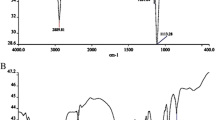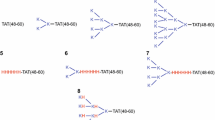Abstract
Gene therapy is a novel method to treat a variety of diseases including genetic disorders and cancer. Nonviral gene carriers have now gained considerable attention as gene carrier systems. Polyamidoamine (PAMAM) and polypropyleneimine (PPI) are the two most widely used denderimers in gene delivery studies. The aim of the current study was to investigate the effects of modification of generation 5 polypropyleneimine (G5 PPI) dendrimers with alkanoate groups as hydrophobic moieties on DNA transfection and cytotoxicity. Six, 10, and 16 carbon derivatives of bromoalkanoic acids were conjugated onto PPI with 10%, 30%, and 50% of surface amine grafting. Ethidium bromide exclusion assay results proved the ability of modified carriers to condense DNA. Transfection assay showed higher DNA delivery potential for 30% and 50% grafting with decanoate moieties compared to native G5 PPI and SuperfectTM. 3-(4,5-Dimethylthiazol-2-yl)-2,5-di phenyltetrazolium bromide (MTT) and apoptosis experiments showed lower toxicity for modified carriers compared to unmodified PPI. The hemolytic effect of grafted carriers was not significantly different from G5 PPI. Size and zeta potential measurements revealed that polyplex size was less than 200 nm and electrical charges were in the range 14–25 mV. The hydrophobic modifications improved transfection activity and toxicity of G5 PPI without negatively affecting hemocompatibility. These modified carriers are therefore promising candidates for further in vivo investigations.








Similar content being viewed by others
References
Wirth T, Parker N, Ylä-Herttuala S. History of gene therapy. Gene. 2013;525(2):162–9.
Li SD, Huang L. Non-viral is superior to viral gene delivery. J Control Release. 2007;123(3):181–3.
Pack DW, Hoffman AS, Pun S, Stayton PS. Design and development of polymers for gene delivery. Nat Rev Drug Discov. 2005;4(7):581–93.
Tomalia DA, Baker H, Dewald J, Hall M, Kallos G, Martin S, et al. A new class of polymers: starburst-dendritic macromolecules. Polym J. 1985;17(1):117–32.
Choi YJ, Kang SJ, Kim YJ, Y-b L, Chung HW. Comparative studies on the genotoxicity and cytotoxicity of polymeric gene carriers polyethylenimine (PEI) and polyamidoamine (PAMAM) dendrimer in Jurkat T-cells. Drug Chem Toxicol. 2010;33(4):357–66.
Dufès C, Uchegbu IF, Schätzlein AG. Dendrimers in gene delivery. Adv Drug Deliv Rev. 2005;57(15):2177–202.
Svenson S, Tomalia DA. Dendrimers in biomedical applications—reflections on the field. Adv Drug Deliv Rev. 2012;64:102–15.
Kim T-I, Baek J-U, Zhe Bai C, Park J-S. Arginine-conjugated polypropylenimine dendrimer as a non-toxic and efficient gene delivery carrier. Biomaterials. 2007;28(11):2061–7.
Tziveleka L-A, Psarra A-MG, Tsiourvas D, Paleos CM. Synthesis and characterization of guanidinylated poly (propylene imine) dendrimers as gene transfection agents. J Control Release. 2007;117(1):137–46.
Russ V, Gunther M, Halama A, Ogris M, Wagner E. Oligoethylenimine-grafted polypropylenimine dendrimers as degradable and biocompatible synthetic vectors for gene delivery. J Control Release. 2008;132(2):131–40.
Schatzlein AG, Zinselmeyer BH, Elouzi A, Dufes C, Chim YT, Roberts CJ, et al. Preferential liver gene expression with polypropylenimine dendrimers. J Control Release. 2005;101(1–3):247–58.
Koppu S, Oh YJ, Edrada-Ebel R, Blatchford DR, Tetley L, Tate RJ, et al. Tumor regression after systemic administration of a novel tumor-targeted gene delivery system carrying a therapeutic plasmid DNA. J Control Release. 2010;143(2):215–21.
Kesharwani P, Tekade RK, Gajbhiye V, Jain K, Jain NK. Cancer targeting potential of some ligand-anchored poly(propylene imine) dendrimers: a comparison. Nanomedicine. 2011;7(3):295–304.
Liu Z, Zhang Z, Zhou C, Jiao Y. Hydrophobic modifications of cationic polymers for gene delivery. Prog Polym Sci. 2010;35(9):1144–62.
Santos JL, Oliveira H, Pandita D, Rodrigues J, Pego AP, Granja PL, et al. Functionalization of poly(amidoamine) dendrimers with hydrophobic chains for improved gene delivery in mesenchymal stem cells. J Control Release. 2010;144(1):55–64.
Doody AM, Korley JN, Dang KP, Zawaneh PN, Putnam D. Characterizing the structure/function parameter space of hydrocarbon-conjugated branched polyethylenimine for DNA delivery in vitro. J Control Release. 2006;116(2):227–37.
Nimesh S, Aggarwal A, Kumar P, Singh Y, Gupta KC, Chandra R. Influence of acyl chain length on transfection mediated by acylated PEI nanoparticles. Int J Pharm. 2007;337(1–2):265–74.
Gabrielson NP, Pack DW. Acetylation of polyethylenimine enhances gene delivery via weakened polymer/DNA interactions. Biomacromolecules. 2006;7(8):2427–35.
Dehshahri A, Oskuee RK, Shier WT, Hatefi A, Ramezani M. Gene transfer efficiency of high primary amine content, hydrophobic, alkyl-oligoamine derivatives of polyethylenimine. Biomaterials. 2009;30(25):4187–94.
Oskuee RK, Dehshahri A, Shier WT, Ramezani M. Alkylcarboxylate grafting to polyethylenimine: a simple approach to producing a DNA nanocarrier with low toxicity. J Gene Med. 2009;11(10):921–32.
Hashemi M, Sahraie HF, Farzad SA, Parhiz H, Ramezani M. Gene transfer enhancement by alkylcarboxylation of poly(propylenimine). Nanomed J. 2013;1(1):55–62.
Snyder SL, Sobocinski PZ. An improved 2, 4, 6-trinitrobenzenesulfonic acid method for the determination of amines. Anal Biochem. 1975;64(1):284–8.
Okuda T, Sugiyama A, Niidome T, Aoyagi H. Characters of dendritic poly(l-lysine) analogues with the terminal lysines replaced with arginines and histidines as gene carriers in vitro. Biomaterials. 2004;25(3):537–44.
Liu Z, Janzen J, Brooks DE. Adsorption of amphiphilic hyperbranched polyglycerol derivatives onto human red blood cells. Biomaterials. 2010;31(12):3364–73.
Incani V, Tunis E, Clements BA, Olson C, Kucharski C, Lavasanifar A, et al. Palmitic acid substitution on cationic polymers for effective delivery of plasmid DNA to bone marrow stromal cells. J Biomed Mater Res A. 2007;81(2):493–504.
Oskuee RK, Philipp A, Dehshahri A, Wagner E, Ramezani M. The impact of carboxyalkylation of branched polyethylenimine on effectiveness in small interfering RNA delivery. J Gene Med. 2010;12(9):729–38.24.
Thomas M, Klibanov AM. Enhancing polyethylenimine’s delivery of plasmid DNA into mammalian cells. Proc Natl Acad Sci U S A. 2002;99(23):14640–5.
Fischer D, Li Y, Ahlemeyer B, Krieglstein J, Kissel T. In vitro cytotoxicity testing of polycations: influence of polymer structure on cell viability and hemolysis. Biomaterials. 2003;24(7):1121–31.
Rejman J, Oberle V, Zuhorn I, Hoekstra D. Size-dependent internalization of particles via the pathways of clathrin- and caveolae-mediated endocytosis. Biochem J. 2004;377:159–69.
Alshamsan A, Haddadi A, Incani V, Samuel J, Lavasanifar A, Uludag H. Formulation and delivery of siRNA by oleic acid and stearic acid modified polyethylenimine. Mol Pharm. 2009;6(1):121–33.
Author information
Authors and Affiliations
Corresponding author
Additional information
Ahad Mokhtarzadeh and Seyed Meghdad Tabatabai contributed equally to this work.
Rights and permissions
About this article
Cite this article
Hashemi, M., Parhiz, H., Mokhtarzadeh, A. et al. Preparation of Effective and Safe Gene Carriers by Grafting Alkyl Chains to Generation 5 Polypropyleneimine. AAPS PharmSciTech 16, 1002–1012 (2015). https://doi.org/10.1208/s12249-015-0284-2
Received:
Accepted:
Published:
Issue Date:
DOI: https://doi.org/10.1208/s12249-015-0284-2




